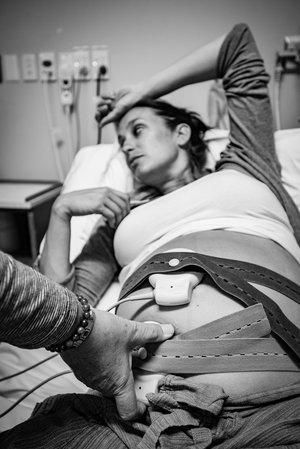30th June, 2019
A passion was born: Our founder’s rise to reason
How Lisa Carnie found her purpose after her traumatic birth experience
Sporting a pink, floaty dress, brightly coloured Portuguese ceramic earrings and long dark hair, Lisa Carnie doesn’t strike you as a typical physiotherapist. Welcoming me into her Pelvic Solutions clinic for a cuppa, the clinician’s professionalism is laced with an exuberance for what she does and a determination to change the status quo. Pelvic Solutions isn’t just a job for Lisa; it’s a passion and a lifestyle, as well as a beacon of hope for many, forged from her own personal story.
Her compassion for others draws from experience. Six years ago, Lisa Carnie was on a single parent benefit, living alone in her new hometown Wanaka with her newborn son. She couldn’t stand for more than 10-minutes at a time after a C-section birth and an epidural anaesthesia went wrong, unintentionally piercing the spinal membrane and inducing an all-encompassing pressure headache that left her temporarily blind for days and in terrible pain. It was a situation she hadn’t prepared for; she had wanted a natural birth, and the thought of an emergency C-section had never crossed her mind. After a week of not being able to hold, feed or see her baby, Lisa hadn’t been able to bond with her son and suffered from the symptoms of birth trauma – going on to feel a debilitating sense of disassociation and emotional numbness for 18-months. Socially isolated and lonely, she lost her sense of self and felt adrift. Unable to exercise, she lost her fitness and sense of wellbeing, while also suffering from prolapse.

Now, Lisa works out of her airy, light-filled clinic with views of Wanaka’s iconic mountains. She opened the doors to her pelvic floor physiotherapy clinic in February, and already has a full-time employee. Every day she helps better people’s lives; from children who are day wetting to women on the cusp of labour; from men who are going through prostate cancer or suffering erectile dysfunction to post-menopausal women who still suffer from painful sex, 50-years after giving birth. And every day Lisa hears up to 10-birth stories from other women, holding a space for them to open up about how it’s affected them. “I still get very emotional talking about my own labour, and I can deeply relate to others when they’re talking about their birth stories,” Lisa says. “The tears usually come as ladies recall their births, no matter how long ago it was. I hold the space for a woman to feel supported and as prepared physically and emotionally as they can be for an upcoming birth, so they can understand their fears and own the birth. Afterwards, giving them really genuine care and the right information to recovery from pregnancy and childbirth, it’s magnificent. I want them to be the best that they can; not just as a mum but as a person; leading the life that she wants, doing the things she wants to be able to do.”
Lisa hasn’t always known about the scale of pelvic floor health. The whole body is dependent on a healthy pelvis – and a dysfunctional one can lead to back and hip pain, erectile dysfunction, poor posture, breathing problems, sleep issues and anxiety. The pelvic floor is a group of muscles surrounding the pelvis; almost like a hammock that supports organs like bladder, bowel and uterus in place. Pelvic floor disorders are common, especially after birth; including urinary and faecal incontinence and pelvic organ prolapse (when the organs start to fall through the bottom of the hammock). “Once I started to learn about what’s in the pelvis, it just opened up a whole new world,” Lisa says. “We’ve got chronic pain patients who’ve seen seven other medical professionals and have tried surgery, medication and specialist after specialist, and haven’t got anywhere till they come and see us. We understand pelvic pain on a larger picture – what really causes it, why it is continuing, how to treat it – it’s amazing the difference we can make and the relief people feel when we can explain to them what’s actually going on.”
Lisa practised as a physio for a decade, working across the industry in a variety of roles internationally. “I found more of a draw to the general public rather than athletes, especially those with less physical ability and in need of more detailed care,” she says. “In Sydney I was working with people with head and spinal cord injuries and worked across all sorts of different areas of physio to try and see where I fit the best, but I didn’t really find my niche there. I was always searching and while I loved it and it was great fun, it was still just a job rather than a real passion.”

It was when Lisa moved overseas that she started finding work that made her soul sing. Basing herself in Wales, the physio travelled around Europe, Africa, South America, India and South East Asia, volunteering with numerous organisations. “I found humanitarian work was where I felt the best, where my soul felt really filled with purpose,” Lisa says. “I then volunteered in Haiti after the earthquake, working with spinal injuries as well as developing a maternal care unit for women and children. The Haitians have a very high maternal mortality rate, so being around these amazing volunteers that were striving to improve care for women in the worst conditions you can imagine, was very inspirational for me.”

After becoming pregnant, in 2013, the then 31-year-old moved home to New Zealand after living abroad for 10 years. “I had my ante-natal care in the UK which is run by the GPs and the practise nurses. It was fine and functional, but nothing remarkable. However, I had a very easy, uncomplicated pregnancy; I was very fit and still exercising,” Lisa says. “I moved to Wanaka as my brother and father were here, and I found the midwifery care very different. My midwife, Mandy was so personable; and deeply caring. But my understanding of the pelvic floor was still not much, if I’m honest. I didn’t have a full understanding of what it did through pregnancy and labour, despite my courses in women’s health and antenatal classes before pregnancy.
Lisa’s son was 10-days overdue, and when her labour began it was intense from the get-go, with three-minute contractions from the start. “My mid-wife was concerned because the baby was posterior, and I wasn’t dilated even though the contractions were so intense. So, we jumped in the car from Wanaka on a winter’s night and drove four hours to Dunedin, our nearest hospital,” Lisa says. “Looking back, I don’t think I really owned my birth, despite having an ‘ideal’ birthing plan. Others made the decisions for me.” After two-days Lisa was given an epidural and told to push. “I couldn’t feel anything. In my preparation for the birth, I hadn’t really thought about the possibility of an epidural or the process of actually pushing my baby out. I couldn’t do it no matter how hard I tried; he was stuck and I was absolutely exhausted,” Lisa says. ‘My midwife was so encouraging and supportive of me to continue to try to push, despite the doctors saying I needed a C-section. I really felt like she was in my corner for as long she possibly could be. The next part was a total blur; I was taken up to theatre and had a C-section and then all of a sudden there was a baby. I remember shaking intensely and the staff said it was a normal response to the medication. Then they showed me this little human and I felt nothing. No connection to this little person who was crying. I was drugged up to my eyeballs and in so much pain, and completely confused about the whole thing. And this was just the beginning.”

On the back of no sleep for four days, the epidural incident meant Lisa couldn’t stand light, movement or sound. “I thought my brain was going to explode. I thought I was going to die,” she says. “A day after the birth they picked up that I had a lumbar puncture so spinal fluid was leaking out from the epidural site. I spent four days in the dark, lying flat in terrible pain.” After two failed procedures, the medical team was finally able to complete a successful blood patch, and four days later she was discharged. “I still couldn’t walk because of back pain from all of the needles into my spinal canal and had to lie flat which made it very hard to care for a baby,” she says. ‘The actual C-section surgical scar was nothing compared to the other pain I was in’.
Lisa started to meditate to handle her stress and sleep, and went back to work as a hospital physiotherapist when her son was 10-months old. While she still had physical issues with her C-section scar, back and prolapse, it was her inner self that struggled the most. “It’s the emotional giving which is a hugely underestimated role of a physio,” she says. “The role of listening and connection and physical touch can be deeply healing for our clients. Getting social support was the biggest contributor to my healing. Gaining friends, getting a tribe, speaking to my academic colleagues at the hospital, and giving to my patients. In the process of becoming a mum, I really lost my professional identity and that was huge for me. Instead of being seen as a professional academic woman, I was seen as a single mum.”

When her son was 18-months-old, Lisa’s life changed forever. “I knew I was looking after this little person and I was fabulous at looking after him because I’m good at looking after people; but it still felt like he was someone else’s baby. I never felt like he was mine, which is such a strange thing to say,” she says. “One day I was playing with my son on the bed and he looked at me and he touched my face with his little hand and I felt this huge rush of love. Up until that point I hadn’t realised how much the feelings weren’t there before that. This little adorable human was actually MY son, and my heart was in pieces with love. I didn’t admit this to anyone else though, as I thought I was supposed to feel that from the beginning like everyone else. But after a few years I got some courage to start talking about it to some friends. Some would simply start crying, and telling me they could relate and how much of a relief it was to talk about it openly. I realised I needed to help women through this process.”
Lisa started her two-year post-grad through Melbourne University, studying pelvic floor and continence rehabilitation for women, men and children. “I was gratefully supported by the hospital to be able to complete the studies, and set up the hospital pelvic health physio service to address the gap in care for women in our local region. I had my head in books every spare second of the day, reading and studying. I became completely obsessed with pelvic health. The post grad was just the beginning; I’ve gone on to do much more advanced courses,” she says. “Now that I’ve realised how many people we can actually help in this field. Pelvic health is the crux of the whole body. It’s not just women, but it’s men with erectile problems or pain; it’s children with constipation and day time or night time wetting. Realising the reach and the influence we can have and impacting people’s lives positively, pushes me to be better. For me I have found my true purpose. My background of humanitarian work makes me a strong advocate for patient groups who don’t have a big voice. The satisfaction comes from helping those whose problems are largely swept under the rug and are considered unimportant. The stigma and shame associated with the conditions that we treat is so huge, and I’m strongly driven to break the taboos and silence so that women, men and children know they don’t have to put up with these problems and that there is good help available. I want to challenge the existing narrative and push funders to put much more importance on continence, and pelvic floor dysfunction. We hold public talks to various community groups most weeks in an effort to change the narrative, so people can understand the difference between what is common and what is normal; and push prevention rather than cure.
Since opening the clinic’s doors the community’s response has been astounding. “A lot of people tell me they wish they’d been told these things earlier. So many people say, where have you been? Why didn’t I know about this kind of therapy? It’s life-changing for them, at all levels, whether they’re athletes training for a marathon and want to improve performance or those who are incontinent and can’t leave the house,” Lisa says. “Other practitioners, your grandmother or your mum might tell you there’s nothing to be done, you just have to put up with it; whether it’s leaking or pain or any dysfunction. I’m here to say it’s not true. Being able to help women through this process, helps me to reconcile a little of my own journey. It does help to realise it’s all for a reason. I went through this process so I can help other women own their birth and not have a similar experience, or help men get their lives back together. I have been there, done that. You can heal too.”




